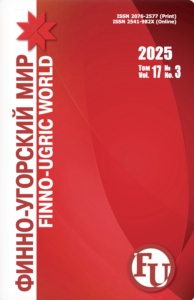DOI: 10.15507/2076-2577.010.2018.03.120-125
Landscape field/meadow archetype in the Mari art of the 1950s–1980s
Elvira M. Kolcheva,
Candidate Sc. {Arts}, Associate Professor,
Department of Monumental and Decorative Art, Painting and Art History,
Kazan State Institute of Culture,
Department of Social and Cultural Technologies,
Mari State University
(Yoshkar-Ola, Russia), elviramk@mail.ru
Despite the official Soviet national policy, the professional art of the USSR peoples developed as a form of artistic reflection of ethnoculture about itself. The author of the article studies this process on the basis of the previously developed structural-archetypal model of the ethno-cultural space of the Mari people.
The article contains the analysis of the artistic representations of the cultural field/meadow archetype on the material of fine art of the 1950s-1980s. The archetype is represented by iconographic types of “Collective Farm Fields of an Epic Scale”, “Harvest”, “Pastures”, “Blossoming Meadows”.
A field, in the style of socialist realism, as a rule, is depicted as a space for heroic deeds, the greatness of the Soviet Motherland and the authorities arranging for the “battle for the harvest”. They glorify the collective farm system seen as a source of abundance and fertility. The masters of the “severe style” introduce the sign-symbolic principle in the image of the field, the artists having already gone beyond the ideological constraints while paving the way for non-romantic trends in the national art. Since the 1970s, the theme of the fields is lyrically approached by the national neoromantic artists who relieve the heroic pathos of socialist realism. The idea of man’s subjugation of nature gave way to the harmonious unity of beingness. The image of the fertile field in the pictures of the national artists was replaced by the images of meadows, pastures and forest glades.
The semantics of the field archetype in the last decade of the Soviet era reveals the meaning of emptiness, loneliness and non-existence, often in combination with the image of a dry tree or a felled grove. It was the way to express feelings about the ongoing assimilation of the nation, about the loss of cultural memory. The evolution of artistic representations of the meadow/field archetype in the period under investigation has shown the failure of an attempt to substitute the traditional perception of nature for the ideaologemes of socialist realism.
Key words: Mari fine art; cultural archetype of the field/meadows; socialist realism; national neo-romanticism.
Acknowledgments: The article was prepared as part of a research project of the RGNF № 15-14-12001 “Ethnocultural space of the Mari people in the fine art of the Mari Territory of the 1950s–1980s”.
For citation: Kolcheva EM. Landscape field/meadow archetype in the Mari art of the 1950s–1980s. Finno-ugorskii mir = Finno-Ugric World. 2018; 3: 120–125. (In Russian)






















